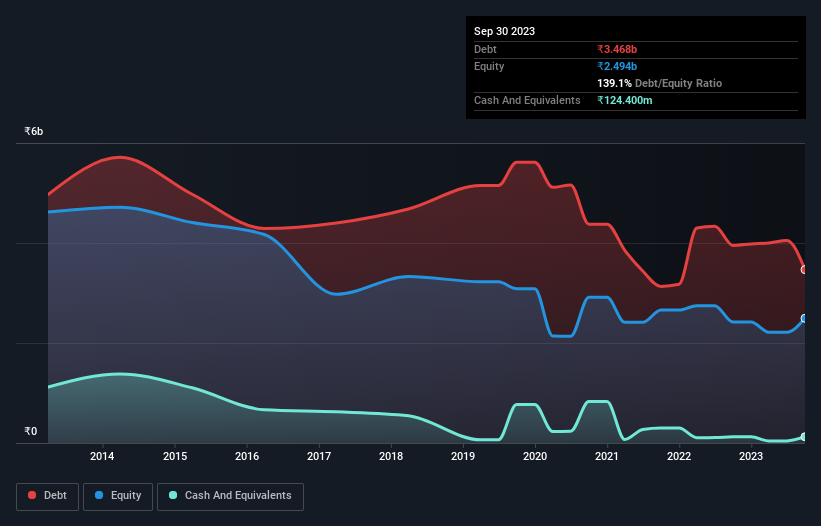Is Jay Shree Tea & Industries (NSE:JAYSREETEA) Using Debt Sensibly?
Warren Buffett famously said, 'Volatility is far from synonymous with risk.' So it seems the smart money knows that debt - which is usually involved in bankruptcies - is a very important factor, when you assess how risky a company is. Importantly, Jay Shree Tea & Industries Limited (NSE:JAYSREETEA) does carry debt. But should shareholders be worried about its use of debt?
Why Does Debt Bring Risk?
Debt assists a business until the business has trouble paying it off, either with new capital or with free cash flow. Part and parcel of capitalism is the process of 'creative destruction' where failed businesses are mercilessly liquidated by their bankers. While that is not too common, we often do see indebted companies permanently diluting shareholders because lenders force them to raise capital at a distressed price. By replacing dilution, though, debt can be an extremely good tool for businesses that need capital to invest in growth at high rates of return. The first step when considering a company's debt levels is to consider its cash and debt together.
View our latest analysis for Jay Shree Tea & Industries
What Is Jay Shree Tea & Industries's Debt?
You can click the graphic below for the historical numbers, but it shows that Jay Shree Tea & Industries had ₹3.47b of debt in September 2023, down from ₹3.95b, one year before. On the flip side, it has ₹124.4m in cash leading to net debt of about ₹3.34b.

How Strong Is Jay Shree Tea & Industries' Balance Sheet?
The latest balance sheet data shows that Jay Shree Tea & Industries had liabilities of ₹4.99b due within a year, and liabilities of ₹1.83b falling due after that. Offsetting these obligations, it had cash of ₹124.4m as well as receivables valued at ₹883.3m due within 12 months. So it has liabilities totalling ₹5.81b more than its cash and near-term receivables, combined.
The deficiency here weighs heavily on the ₹2.77b company itself, as if a child were struggling under the weight of an enormous back-pack full of books, his sports gear, and a trumpet. So we definitely think shareholders need to watch this one closely. After all, Jay Shree Tea & Industries would likely require a major re-capitalisation if it had to pay its creditors today. The balance sheet is clearly the area to focus on when you are analysing debt. But you can't view debt in total isolation; since Jay Shree Tea & Industries will need earnings to service that debt. So when considering debt, it's definitely worth looking at the earnings trend. Click here for an interactive snapshot.
In the last year Jay Shree Tea & Industries wasn't profitable at an EBIT level, but managed to grow its revenue by 8.5%, to ₹8.3b. We usually like to see faster growth from unprofitable companies, but each to their own.
Caveat Emptor
Over the last twelve months Jay Shree Tea & Industries produced an earnings before interest and tax (EBIT) loss. Its EBIT loss was a whopping ₹458m. When we look at that alongside the significant liabilities, we're not particularly confident about the company. It would need to improve its operations quickly for us to be interested in it. Not least because it had negative free cash flow of ₹920m over the last twelve months. That means it's on the risky side of things. The balance sheet is clearly the area to focus on when you are analysing debt. But ultimately, every company can contain risks that exist outside of the balance sheet. To that end, you should learn about the 3 warning signs we've spotted with Jay Shree Tea & Industries (including 1 which doesn't sit too well with us) .
At the end of the day, it's often better to focus on companies that are free from net debt. You can access our special list of such companies (all with a track record of profit growth). It's free.
New: Manage All Your Stock Portfolios in One Place
We've created the ultimate portfolio companion for stock investors, and it's free.
• Connect an unlimited number of Portfolios and see your total in one currency
• Be alerted to new Warning Signs or Risks via email or mobile
• Track the Fair Value of your stocks
Have feedback on this article? Concerned about the content? Get in touch with us directly. Alternatively, email editorial-team (at) simplywallst.com.
This article by Simply Wall St is general in nature. We provide commentary based on historical data and analyst forecasts only using an unbiased methodology and our articles are not intended to be financial advice. It does not constitute a recommendation to buy or sell any stock, and does not take account of your objectives, or your financial situation. We aim to bring you long-term focused analysis driven by fundamental data. Note that our analysis may not factor in the latest price-sensitive company announcements or qualitative material. Simply Wall St has no position in any stocks mentioned.
About NSEI:JAYSREETEA
Jay Shree Tea & Industries
Jay Shree Tea & Industries Limited cultivates, produces, and sells tea, sugar, and fertilizers in India and internationally.
Slight risk second-rate dividend payer.
Market Insights
Community Narratives



